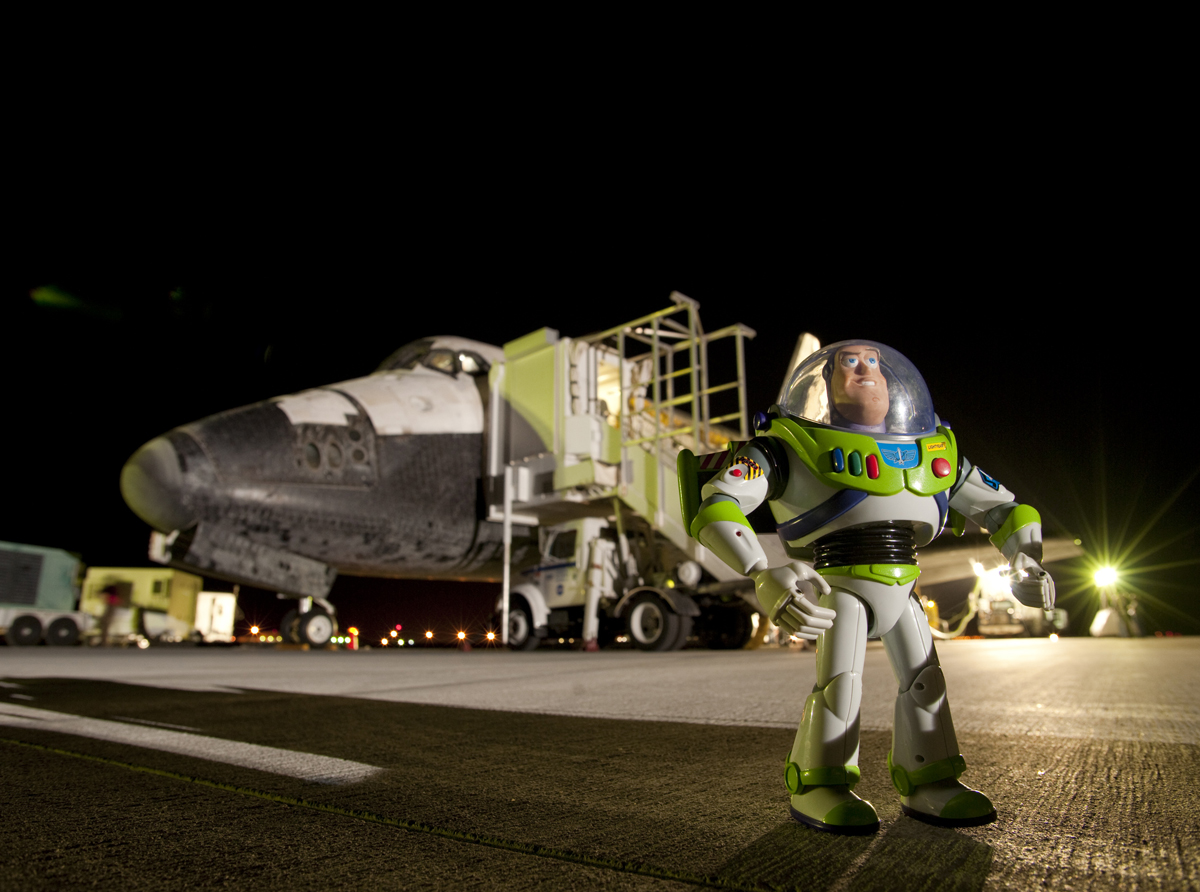To the Museum and Beyond! Space-Flown Buzz Lightyear Heads to Smithsonian

The final chapter in a Buzz Lightyear toy's story will play out later this month at the National Air and Space Museum in Washington, D.C.
On March 29, a 12-inch (30.5-centimeter) action figure of the space ranger made famous in the Disney-Pixar "Toy Story" franchise will be donated to the national aerospace archive. The "not a flying toy" figure was earlier flown to the real International Space Station (ISS), where it stayed for 467 days orbiting the Earth.
"Be here when Buzz Lightyear arrives," the National Air and Space Museum recently invited on its website. "The museum will host a presentation with Pixar and NASA for a ceremonial donation of the Buzz Lightyear action figure that flew on space shuttle Discovery to the International Space Station."
The museum, which only a few weeks later on April 19 will take delivery of Lightyear's ride to space, Discovery, to be displayed at its Steven F. Udvar-Hazy Center in Virginia, plans to exhibit the well-traveled astronaut toy as part of its shuttle-themed "Moving Beyond Earth" gallery later this year.
John Lasseter, the animator who created Buzz Lightyear and who is now the chief creative officer at Pixar and Walt Disney Animation Studios, will attend the ceremony, along with representatives from NASA and the Smithsonian. [9 Weird Things Flown on Space Shuttles]
A dream come true
Buzz Lightyear's arrival at the Smithsonian will complete a vision for the toy that Lasseter expressed while the figure was still in space.
Breaking space news, the latest updates on rocket launches, skywatching events and more!
"Frankly, I would love it to go to the Smithsonian so that kids can actually see this Buzz went to space," Lasseter told collectSPACE.com in 2009 interview.
Space shuttle Discovery delivered Lightyear to the space station in June 2008 as part of an educational partnership between NASA and the Walt Disney Company. In addition to launching the toy to space, the collaboration included a mission patch design contest for students and a series of educational online games and videos, the latter featuring footage of the figure floating in space.
Disney celebrated the space ranger's real space adventure at its amusement parks, too. During festivities held at the Disneyland Resort in California in June 2008, the figure's flight footage debuted before an audience of park visitors.
More than a year later, Disney World's Magic Kingdom in Florida threw a ticker-tape parade to welcome the space-flown Lightyear back to Earth. The parade featured NASA astronaut Mike Fincke, who was on the space station with the Lightyear toy, and Apollo moonwalker Buzz Aldrin, the character's namesake.
For Lasseter, the Buzz Lightyear figure's entire journey, from the space station to Main Street to the Smithsonian, has been a dream come true.
"It is a character I created and for us at Pixar to have him go, there are so many times I've said, 'It is a dream come true,' but this one truly, truly is," Lasseter said.
At home in the Smithsonian
Had Buzz Lightyear been a real astronaut, his 467 days in space would have set the record for the most time in orbit by an American space traveler, an accomplishment more than worthy for celebration in the National Air and Space Museum.
But even if "just a toy" — as a memorable line from "Toy Story" emphasized — Buzz Lightyear still fits well in the museum. Among other cultural and social artifacts, the Smithsonian's space collection includes Magellan T. Bear, the "first official teddy bear in space," which launched on an earlier mission on space shuttle Discovery.
Lightyear's look also blends among other artifacts in the National Air and Space Museum, especially the spacesuit worn by the "other" Buzz, Aldrin.
"A big part of his design was based on how the Apollo astronauts looked," Lasseter said in 2009. "That's why he is primarily white and he has that big, clear helmet and he has a skullcap; it's very much based upon the real NASA astronauts."
Click through to collectSPACE.com to see video of the Buzz Lightyear 12-inch figure floating aboard the International Space Station.
Follow collectSPACE on Facebook and Twitter @collectSPACE and editor Robert Pearlman @robertpearlman. Copyright 2012 collectSPACE.com. All rights reserved.

Robert Pearlman is a space historian, journalist and the founder and editor of collectSPACE.com, a daily news publication and community devoted to space history with a particular focus on how and where space exploration intersects with pop culture. Pearlman is also a contributing writer for Space.com and co-author of "Space Stations: The Art, Science, and Reality of Working in Space” published by Smithsonian Books in 2018.
In 2009, he was inducted into the U.S. Space Camp Hall of Fame in Huntsville, Alabama. In 2021, he was honored by the American Astronautical Society with the Ordway Award for Sustained Excellence in Spaceflight History. In 2023, the National Space Club Florida Committee recognized Pearlman with the Kolcum News and Communications Award for excellence in telling the space story along the Space Coast and throughout the world.

